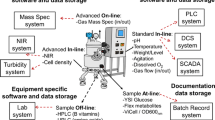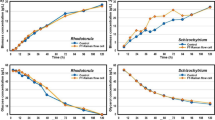Abstract
Compared to small molecule process analytical technology (PAT) applications, biotechnology product PAT applications have certain unique challenges and opportunities. Understanding process dynamics of bioreactor cell culture process is essential to establish an appropriate process control strategy for biotechnology product PAT applications. Inline spectroscopic techniques for real time monitoring of bioreactor cell culture process have the distinct potential to develop PAT approaches in manufacturing biotechnology drug products. However, the use of inline Fourier transform infrared (FTIR) spectroscopic techniques for bioreactor cell culture process monitoring has not been reported. In this work, real time inline FTIR Spectroscopy was applied to a lab scale bioreactor mAb IgG3 cell culture fluid biomolecular dynamic model. The technical feasibility of using FTIR Spectroscopy for real time tracking and monitoring four key cell culture metabolites (including glucose, glutamine, lactate, and ammonia) and protein yield at increasing levels of complexity (simple binary system, fully formulated media, actual bioreactor cell culture process) was evaluated via a stepwise approach. The FTIR fingerprints of the key metabolites were identified. The multivariate partial least squares (PLS) calibration models were established to correlate the process FTIR spectra with the concentrations of key metabolites and protein yield of in-process samples, either individually for each metabolite and protein or globally for all four metabolites simultaneously. Applying the 2nd derivative pre-processing algorithm to the FTIR spectra helps to reduce the number of PLS latent variables needed significantly and thus simplify the interpretation of the PLS models. The validated PLS models show promise in predicting the concentration profiles of glucose, glutamine, lactate, and ammonia and protein yield over the course of the bioreactor cell culture process. Therefore, this work demonstrated the technical feasibility of real time monitoring of the bioreactor cell culture process via FTIR spectroscopy. Its implications for enabling cell culture PAT were discussed.

Similar content being viewed by others
References
FDA/ICH. Guidance for Industry Q11 Development and Manufacture of Drug Substances. FDA, 2012. Available at: http://www.fda.gov/downloads/Drugs/Guidances/UCM261078.pdf (accessed on 07/28/2015)
FDA. Guidance for Industry PAT—A Framework for Innovative Pharmaceutical Development, Manufacturing, and Quality Assurance. FDA, 2004. Available at: http://www.fda.gov/downloads/Drugs/Guidances/ucm070305.pdf (accessed on 07/28/2015)
FDA. Advancing Regulatory Science at FDA: A Strategic Plan. FDA, 2011. Available at: http://www.fda.gov/downloads/scienceresearch/specialtopics/regulatoryscience/ucm268225.pdf (accessed on 07/28/2015)
Wu H Q, Khan M A, Hussain A S. Process control perspective for process analytical technology: Integration of chemical engineering practice into semiconductor and pharmaceutical industries. Chemical Engineering Communications. 2007, 194(6): 760–779
Read E K, Park J T, Shah R B, Riley B S, Brorson K A, Rathore A S. Process analytical technology (PAT) for biopharmaceutical products: Part I. Concepts and applications. Biotechnology and Bioengineering. 2010, 105(2): 276–284
Glassey J, Gernaey K V, Clemens C, Schulz T W, Oliveira R, Striedner G, Mandenius C F. Process analytical technology (PAT) for biopharmaceuticals. Biotechnology Journal. 2011, 6(4): 369–377
Simon L L, Pataki H, Marosi G, Meemken F, Hungerbühler K, Baiker A, Tummala S, Glennon B, Kuentz M, Steele G, Kramer H J M, Rydzak J W, Chen Z, Morris J, Kjell F, Singh R, Gani R, Gernaey K V, Louhi-Kultanen M, O’Reilly J, Sandler N, Antikainen O, Yliruusi J, Frohberg P, Ulrich J, Braatz R D, Leyssens T, von Stosch M, Oliveira R, Tan R B H, Wu H, Khan M, O’Grady D, Pandey A, Westra R, Delle-Case E, Pape D, Angelosante D, Maret Y, Steiger O, Lenner M, Abbou-Oucherif K, Nagy Z K, Litster J D, Kamaraju V K, Chiu M S. Assessment of recent process analytical technology (PAT) trends: A multiauthor review. Organic Process Research & Development. 2015, 19(1): 3–62
Wu H, Dong Z, Li H, Khan M A. An integrated process analytical technology (PAT) approach for pharmaceutical crystallization process understanding to ensure product quality and safety: FDA scientist’s perspective. Organic Process Research & Development. 2015, 19(1): 89–101
Wu H, Heilweil E, Hussain A S, Khan M A. Process analytical technology (PAT): Quantification approaches in Terahertz spectroscopy for pharmaceutical application. Journal of Pharmaceutical Sciences. 2007, 97(2): 970–984
Wu H, Khan M A. THz spectroscopy: An emerging technology for pharmaceutical development and pharmaceutical process analytical technology (PAT) applications. Journal of Molecular Structure. 2012, 1020: 112–120
Wu H, Khan M A. Quality-by-design (QbD): An integrated approach for evaluation of powder blending process kinetics and determination of powder blending end-point. Journal of Pharmaceutical Sciences. 2009, 98(8): 2784–2798
Wu H, White M, Khan M A. An integrated process analytical technology (PAT) approach for process dynamics-related measurement error and process design space development for a pharmaceutical powder blending bed. Organic Process Research & Development. 2015, 19(1): 215–226
Wu H, White M, Khan M A. Quality-by-design (QbD): An integrated process analytical technology (PAT) approach for a dynamic pharmaceutical co-precipitation process characterization and process design space development. International Journal of Pharmaceutics. 2011, 405(1–2): 63–78
Wu H, White M, Berendt R, Foringer R, Khan M A. An integrated PAT approach for nucleation induction time measurement and nucleation mechanism assessment for a dynamic multi-component pharmaceutical antisolvent crystallization system. Industrial & Engineering Chemistry Research. 2014, 53(4): 1688–1701
Wu H, Lyon R C, Khan M A, Voytilla R, Drennen J III. Integration of near-infrared spectroscopy and mechanistic modeling for predicting film-coating and dissolution of modified release tablets. Industrial & Engineering Chemistry Research. Accepted for publication on May 19, 2015. http://pubs.acs.org/doi/abs/10.1021/ie504680m
Chung H, Arnold M A, Rhiel M, Murhammer D W. Simultaneous measurements of glucose, glutamine, ammonia, lactate, and glutamate in aqueous solutions by near-infrared spectroscopy. Applied Spectroscopy. 1996, 50(2): 270–276
Cervera A E, Petersen N, Lantz A E, Larsen A, Gernaey K V. Application of near-infrared spectroscopy for monitoring and control of cell culture and fermentation. Biotechnology Progress. 2009, 25(6): 1561–1581
Liu K Z, Mantsch H H. Simultaneous quantitation from infrared spectra of glucose concentrations, lactate concentrations, and lecithin/sphingomyelin ratios in amniotic fluid. American Journal of Obstetrics and Gynecology. 1999, 180(3): 696–702
Petersen N, Odman P, Padrell A E, Stocks S, Lantz A E, Gernaey K V. In situ near infrared spectroscopy for analyte-specific monitoring of glucose and ammonium in streptomyces coelicolor fermentations. Biotechnology Progress. 2010, 26(1): 263–271
Jose G E, Folque F, Menezes J C, Werz S, Strauss U, Hakemeyer C. Predicting mab product yields from cultivation media components, using near-infrared and 2D-fluorescence spectroscopies. Biotechnology Progress. 2011, 27(5): 1339–1346
Abu-Absi N R, Kenty B M, Cuellar M E, Borys M C, Sakhamuri S, Strachan D J, Hausladen M C, Li Z J. Real time monitoring of multiple parameters in mammalian cell culture bioreactors using an in-line Raman spectroscopy probe. Biotechnology and Bioengineering. 2011, 108(5): 1215–1221
Budinova G, Salva J, Volka K. Application of molecular spectroscopy in the mid-infrared region to the determination of glucose and cholesterol in whole blood and in blood serum. Applied Spectroscopy. 1997, 51(5): 631–635
Petibois C, Cazorla G, Cassaigne A, Deleris G. Plasma protein contents determined by Fourier-transform infrared spectrometry. Clinical Chemistry. 2001, 47(4): 730–738
Ellis D I, Goodacre R. Metabolic fingerprinting in disease diagnosis: Biomedical applications of infrared and Raman spectroscopy. Analyst (London). 2006, 131(8): 875–885
Haris P I, Chapman D. Does Fourier-transform infrared-spectroscopy provide useful information on protein structures. Trends in Biochemical Sciences. 1992, 17(9): 328–333
Gross-Selbeck S, Margreiter G, Obinger C, Bayer K. Fast quantification of recombinant protein inclusion bodies within intact cells by FTIR spectroscopy. Biotechnology Progress. 2007, 23(3): 762–766
Stuart B H, Ando D J, eds. Biological Applications of Infrared Spectroscopy. New York: John Wiley & Sons, Inc., 1997, 191
Sellick C A, Hansen R, Jarvis R M, Maqsood A R, Stephens G M, Dickson A J, Goodacre R. Rapid monitoring of recombinant antibody production by mammalian cell cultures using fourier transform infrared spectroscopy and chemometrics. Biotechnology and Bioengineering. 2010, 106(3): 432–442
Read E K, Bradley S A, Smitka T A, Agarabi C D, Lute S C, Brorson K A. Fermentanomics informed amino acid supplementation of an antibody producing mammalian cell culture. Biotechnology Progress. 2013, 29(3): 745–753
Delwiche S R, Reeves J B III. A graphical method to evaluate spectral proprecessing in multivariate regression calibrations: example with Savtzky-Golay filters and partial least squares regression. Applied Spectroscopy. 2010, 64(1): 73–82
Wu H, Khan M A. Quality-by-design (QbD): An integrated process analytical technology (PAT) approach for real-time monitoring and mapping the state of a pharmaceutical co-precipitation process. Journal of Pharmaceutical Sciences. 2010, 99(3): 1516–1534
FDA/ICH. Guidance for Industry Q8(R2) Pharmaceutical Development. FDA, 2009. Available at: http://www.fda.gov/downloads/Drugs/Guidances/ucm073507.pdf (accessed on 07/28/2015)
Author information
Authors and Affiliations
Corresponding author
Additional information
Disclaimer: The article reflects the views of the authors and should not be construed to represent FDA views or policies
Dedicated to the 120th Anniversary of Tianjin University
Rights and permissions
About this article
Cite this article
Wu, H., Read, E., White, M. et al. Real time monitoring of bioreactor mAb IgG3 cell culture process dynamics via Fourier transform infrared spectroscopy: Implications for enabling cell culture process analytical technology. Front. Chem. Sci. Eng. 9, 386–406 (2015). https://doi.org/10.1007/s11705-015-1533-3
Received:
Accepted:
Published:
Issue Date:
DOI: https://doi.org/10.1007/s11705-015-1533-3




